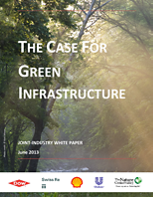
Transforming Business Practices
Building the Case for Green Infrastructure
Research finds that incorporating nature into man-made infrastructure can improve business resilience.
Earlier this year, experts from The Dow Chemical Company, Shell, Swiss Re, and Unilever, working with The Nature Conservancy and a resiliency expert, evaluated a number of business case studies, and developed a white paper with recommendations that green and hybrid infrastructure solutions should become part of the standard toolkit for modern engineers.
Green infrastructure employs elements of natural systems, while traditional gray infrastructure is man-made. Examples of green infrastructure include creating oyster reefs for coastal protection, and reed beds that treat industrial waste water.
The research team evaluated the assumption that green infrastructure can provide more opportunities than gray infrastructure to increase the resilience of industrial business operations against disruptive events such as mechanical failure, power interruption, raw material price increases, and floods. The evaluation concluded that hybrid approaches, utilizing a combination of green and gray infrastructure, may provide an optimum solution to a variety of shocks and improve the overall business resilience.
The case studies gathered to support this research encompass a wide variety of possible applications of green infrastructure. They range from planting trees that cost-effectively remediate contaminated soil (phytoremediation), to constructing wetlands that naturally treat industrial wastewater, to mitigating air pollution through innovative forest management approaches.
This joint-industry effort will continue to explore ways and develop tools to better evaluate green versus gray solutions with the aim to better understand under what circumstances green infrastructure is a cost effective investment.
Members hope to influence fellow companies and organizations to pursue green and/or hybrid solutions when financially appropriate.
